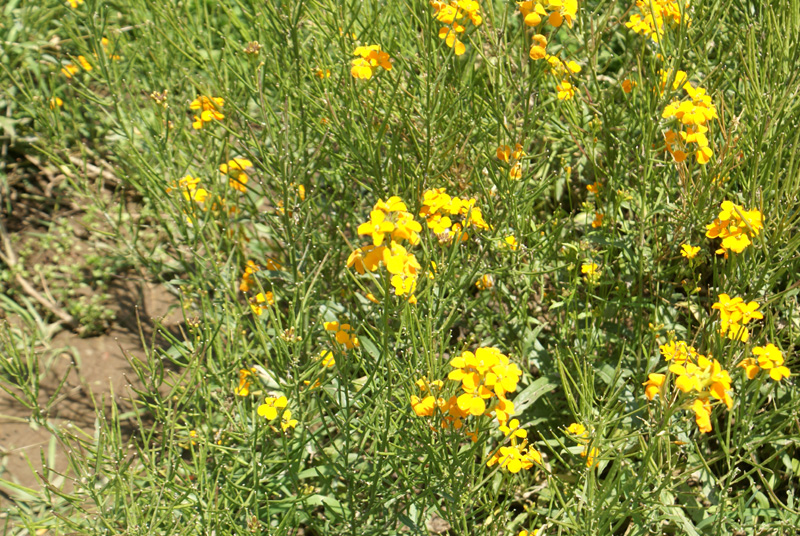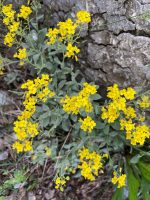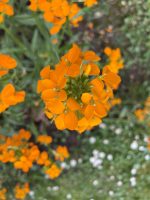|
Erysimum×cheiri (L.) Crantz, Cl. Crucif. Emend. 116 1769. (syn: Cheiranthus×cheiri L.; Cheiranthus×fruticulosus L.; Cheiranthus×fruticulosus (Spreng.) L’Hér. ex DC.; Cheiranthus×helveticus Jacq.; Cheiranthus×intermedius Schleich.; Cheiranthus×luteus Dulac; Cheiranthus×muralis Salisb.; Cheiri×vulgare Clairv.; Erysimum×helveticum (Jacq.) DC.; Erysimum×suffruticosum Spreng.);
. Brassicaceae Week Erysimum cheiri from Delhi and Kashmir:
Erysimum cheiri (L.) Crantz syn: Cheiranthus cheiri L.
common names Wallflower, Giroflee, Goldback.
Perennial herb up to 70 cm tall, appressed pubescent; leaves lanceolate, entire, 3-8 cm long, sometimes clustered below flowers and on sterile shoot tips; flowers 20-25 mm across, yellow to yellow-brown in terminal racemes; petals much longer than sepals; siliqua 4-ngled, 5-7 cm long
Commonly grown in temperate climate, rarer in Delhi. No wonder it was displayed under the title of Schizanthus at Delhi University Flower Show. Commonly grown in Kashmir SK297JAN05-2016:ID : 11 posts by 4 authors. Attachments (3)
Location: Jomsom, Mustang, Nepal
Altitude: 9200 ft.
Date: 21 April 2013
Brassicaceae member ? Quite an eye-catching colour to the flowers, though being rather ‘gaudy’ I immediately suspect it may be cultivated (or an ‘escape’ from
cultivation) possibly naturalised. Such plants have limited interest to me – though are clearly are part of the flora (sometimes a significant part).
Where I live in the UK, at the edge of a town, MANY of the species I find locally are naturalised or escapes from cultivation as well as there being
a diverse range of plants cultivated in private gardens.
It is certainly Brassicaceae family (previously Cruciferae) and I have a copy of Flora of Mustang but this is FAR from complete and I am not sure how well cultivated plants or escapes from cultivation are covered – ASSUMING the specimen photographed at Jomsom, is one of these and not a wild species.
I will look into this further. I have had another look but this Brassicaceae continues to defeat me at this time.
I still consider this is likely to be a cultivated plant/escape from cultivation on the basis of the flower colour.
Any suggestions from others – cannot justify spending any more time on it.
This comes close to Cheiranthes cheiri, a widely cultivated garden annual, nothing else comes to mind…!! Thank you for the ID.
Erysimum cheiri(L.) Crantz (accepted name)
I am in agreement that the plant photographed comes close to what Stewart knew in Pakistan as ‘The Garden Wallflower’ (Cheiranthus cheiri) –
where it was much cultivated in flower gardens.
However, it was not a FIRM identification.
Enumeration of the Flowering Plants of Nepal does not mention it but this concentrated upon WILD plants. No mention in Flora of Bhutan nor the Dickore & Klimes Ladakh check-list (2005) – they included many cultivated species with the arid conditions there similar to Jomsom.
The Plant List also has this currently under Erysimum cheiri but that data-base considers the name “unresolved”.
By the way Cheiranthus cheiri ‘Wallflower’ is a native of cliffs & rocks in Greece, Crete, W.Turkey & W.Syria. Flowers in the wild are deep yellow. It is naturalised on walls in most of the rest of Europe. Flower colour in cultivated wallflowers varies from red to pinkish or brown, yellow and cream.
There are quite a number of cultivated wallflowers. Many of the cultivars including hybrids of a number of other species.
I therefore think it best to say perhaps a garden wallflower.
Thank you … ! I guess it is not the native to Nepal rather introduced and pictured in a garden !
.
Looks like Cheiranthus cheiri I guess the correct ID by … Maybe as per images at .
Looks like. Can you please post whole plant and leaf images ? I do not have any other pic. But attaching a cropped image with the leaves, if it helps. I guess the ID is correct ! If cultivated in beds, it should be E. cheiri Yes Sir ji, it seemed to be cultivated in a flower bed in Shalimar Bagh. Sir ji, but the leaf margins do not match with the E. x cheiri pics on eFI. Please advise. I think … id seems to be Ok as per images at
. References:
|














